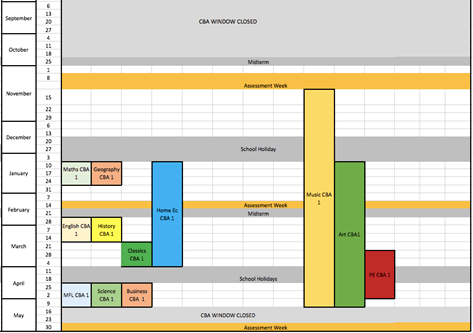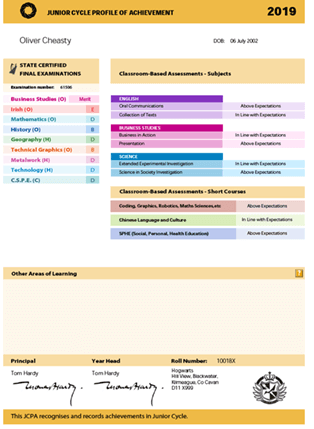By Conor Maxwell and Holly Murray
Overview
As a parent you may hear your child say “my history CBA is beginning next week and I need help with this!” Your first reaction may be “what is a CBA? I never did that in school.”
If this is your reaction then you are not alone as most parents are unsure of this new process of assessment as part of the new Junior Cycle.
By way of background, the new Junior Cycle brought around many changes within the classroom. The Framework for Junior Cycle (2015) outlines these key educational changes that the Department of Education and Skills put in place for students in the first three years of their post-primary education. One of the most notable changes was the introduction of Classroom-Based Assessments and Assessment Tasks for each subject studied by students. The CBAs offer a broad and balanced educational experience for your child.
In this joint article, secondary school teachers Holly Murray and Conor Maxwell outline in detail what are CBAs, the timeline of CBAs, real world examples, how they are graded and finally advice for your children.
What is a CBA? How does it work?
Each student will undertake a number of Classroom-Based Assessments, facilitated by their teacher throughout their Junior Cycle. There are 2 CBAs to be completed per subject (1 in second year and 1 in third year), & 1 CBA to be completed per short course (in third year). All CBAs are specified at common level.
In Visual Art a student who does not complete CBA2 cannot complete Visual Art project in third year for the SEC examination. Although CBAs offers a snap shot of where the student is at in their learning they also (in some subjects) must be completed in order to complete 3rd year project”
– Siobhan Lynch
When do CBAs take place?
They take place during normal class time during a designated CBA window. Schools have freedom to schedule them anytime within this window.
Care will be given to ensure that there are not too many CBAs taking place at any one time. A schedule will be drawn up within the school and shared. The vast majority of CBAs will be completed over a three-week period, with the exception of the likes of PE, Home Economics, Music & Art which are longer. An example of a CBA calendar can be seen below.

What does a CBA entail?
Every subject and every teacher will have different expectations for the CBA in their subjects. What is important to note is that the assessments associated with the CBA will be tied to the skills and knowledge linked with the subject or short course being studied.
For example, science CBA could be proving an experiment but a history CBA could be creating a presentation on Hitler.
Example of Science and Maths CBAs
by Conor Maxwell
An example of the first CBA that students complete in Science is an Extended Experimental Investigation (EEI). The task, as outlined by the NCCA is: “students will, over a three-week period; formulate a scientific hypothesis, plan and conduct an experimental investigation to test their hypotheses, generate and analyse primary data, and reflect on the process, with support/ guidance by the teacher.”
Another example is the second CBA completed by Maths students in third year. This is a Statistical Investigation and the task is defined as: “students will, over a three-week period; follow the Statistical enquiry cycle. Statistical enquiry cycle: formulate a question; plan and collect unbiased, representative data; organise and manage the data; explore and analyse the data using appropriate displays and numerical summaries and answer the original question giving reasons based on the analysis section.”
CBAs can come in the format of digital portfolios, oral presentations, projects, written essays, or a combination of a few various aspects.
Examples of History and Geography CBAs
by Holly Murray
My current second years will be creating a digital portfolio using Google Sites for their CBA1 in history and creating a digital newspaper using an application called Wakelet for their geography CBA1.
Google Sites will teach my students how to create their own website based on all the information they have researched over the three-week period. This is a fantastic skill to learn in post-primary school and will benefit students in their future employment or educational experiences.
History CBA1s title is ‘The Past in My Place’ and CBA1 in geography is called ‘Geography in The News’. Both titles require the students to engage in online research.
The CBAs encourage the use of the NCCA key skills of being creative, working with others, time management and communication. It is important to note that every teacher will opt for a digital form of assessment for the CBA1s in their subjects.
These tasks will be familiar to students from what they will have been covering in class and so will be an opportunity for them to showcase their skills and explore an area of particular interest to them.
CBA tasks for all subjects and short courses will be outlined to students in a very similar way to the ones above. Should you want to get an overview of the tasks for yourself, this can be done by clicking here. Simply selected a desired subject and view the document entitled “specification”.
CBAs can come in the format of digital portfolios, oral presentations, projects, written essays, or a combination of a few various aspects.
Examples of Students Work
Students will have freedom within reason, to approach the CBA in a way of their choosing in terms of the content of the CBA and the way it is presented. To give you an idea of how each product produced by students for their CBA can differ, I included examples below of Maths and Science CBAs completed by students.
You will see that even though each student was following the exact same task, the content within the work produced, and the way in which it was presented was completely different for each student. Some were hand-written, some were presented in a PPT, others were typed up. The sky is the limit.
Full examples of CBAs completed by my own students can be seen here.
Examples for other subjects can be found here and selecting an appropriate subject and clicking ‘Examples of Student Work’.
How are the CBAs graded?
The CBAs are not graded the same as your child’s class tests or the state exams in the Junior Cycle.
There are four level descriptors of achievement in each Classroom-Based Assessment:
• Exceptional describes a piece of work that is of an extremely high standard.
• Above expectations grade describes a piece of work that reflects a particularly good piece of work but with feedback from the teacher the student has potential to improve.
• In line with expectations grade describes a piece of work that reflects most of the Features of Quality for the Classroom-Based Assessment well. It shows a goodunderstanding of the task in hand and is free from significant error.
• Yet to meet expectations grade describes a piece of work that falls someway short of the demands of the classroom-Based Assessment and its associated Features of Quality. The student has made a good attempt, but the task has not been grasped clearly. This grade also enables a student to progress to the 3rd year project.
A ‘Not reported’ is granted if a student does not make any attempt at producing any work for their CBA.
The grades of these CBAs will appear on a student’s Junior Cycle Profile of Achievement (JCPA) along with their final examination grades. An example of a JCPA can be seen below.

One of these descriptors will be provisionally awarded to a student for each CBA completed. This will be done by the student’s teacher. Each CBA will be assessed using designated ‘Features of Quality’ provided by the NCCA.
These Features of Quality support student and teacher judgement of the CBAs and are unique for each CBA completed.
When using the Features of Quality to assess the level of student achievement in a CBA, teachers use ‘on-balance’ judgement.
The teacher reads the Features of Quality (starting with Yet to Meet Expectations) until they reach a descriptor that best describes the work being assessed. It is not a requirement that all features of a grade descriptor are met for that descriptor to be awarded.
However, if not all features are met, then the entirety of the piece of work must, ‘on balance’, be of a sufficient standard to be awarded that descriptor.
Following the awarding of provisional descriptors, teachers within subject departments will engage in a Subject Learning and Assessment Review (SLAR). This SLAR enables teachers to collaboratively reach consistency in their judgements of student work against the Features of Quality. The main objectives of this review process are to achieve:
- Greater consistency of teachers’ judgement
- Better feedback to student
- Greater alignment of judgements with expected standards
Following this SLAR, subject teachers may need to revisit the provisional grades awarded and make some changes based on the discussions had. Only the final grade descriptor will be given to students and this will then appear on their Junior Cycle Profile of Achievement.
For more information on how your child’s achievements are acheived and recorded, please see the jcpa handbook and the leaflet
Assessment Tasks
Following completion of the second CBA in individual subjects, students complete a written Assessment Task to be submitted to the State Examinations Commission for marking as part of the state-certified examination for that subject. It will be allocated 10% of the marks used to determine the grade awarded by the State Examinations Commission.
The Assessment Task is directly related to the nature and focus of the second Classroom-Based Assessment. The purpose of the Assessment Task is for students to undertake a focused reflection on their individual CBA.
The Assessment Task again takes place during class time. The mark awarded for the Assessment Task will be aggregated by the SEC with the mark awarded for the final examination (which takes place in June) to determine the overall grade for the state-certified final examination in each subject. There is no Assessment Task to be completed in short courses.
Advice to give your child on CBAs
- Follow all of their teachers’ instructions.
- Use their class time wisely. Three weeks does fly by.
- Keep track of their sources they use when researching.
- Do not copy and paste directly from the Internet and pretend it is their work because they will get caught.
- Ask for help if they are stuck.
- Encourage them to present their findings at home as practice incase they must do a class presentation.
To conclude the CBAs are a fun and interactive three weeks in class as it gives the students a break from the ‘Chalk and Talk’ approach of learning, and they can be involved in more active learning methods.
Engaging in research also helps the students to think critically and find information for themselves which is crucial to prepare them for life outside of a classroom. Encouraging the use of digital technologies to use in the CBAs can give the students a break from writing and can also help students with spelling and grammar as tools such as Google Docs will check this for them.
By Conor Maxwell
Conor is a science, maths and coding teacher in Sandymount Park Educate Together Secondary School. Conor is ICT Coordinator in his school and gives training sessions top both his students and fellow teachers. He is a certified Microsoft Innovative Educator Expert and Apple Certified Teacher and he believes strongly that when used effectively in the classroom, technology can have a transformational impact on student learning.
By Holly Murray
Holly is a Geography and History teacher in Finn Valley College, Donegal. She is a certified Apple Teacher and a certified Microsoft Innovative Educator. Further, Holly is a EAL advisor for the PDST and A Google Certified educator level 1&2. Holly is an expert when it comes to using technology in the classroom, with a particular passion for accessibility and inclusion.



